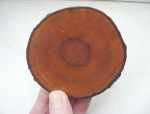
Timber from Fruit Trees
INTRODUCTION
The varieties of trees of this description are almost innumerable. So much has been done by grafting, cultivation, inoculating, and mixing of sorts, that the knowledge of these sorts has almost become a science in itself.
Considered merely as timber-trees, they are much more simple. They may be divided into two classes: stone-fruits, and fruits which have seeds or pips.
With the exception of the peach, nectarine and almond, which form the genus Amygdalus, all ofthe stone fruits are contained in the genus Prunus.
The seeded fruits are contained within the genus Pyrus or Mespilus.
None of the genus Amygdalus are reared as timber-trees in any part of Britain, so we will confine ourselves to the others.
The wood of these two genera is close and compact and takes a good polish. The wild sorts are better than the cultivated; the higher the cultivation, the worse the wood.
A general rule is that self-planted trees give the best timber. Another rule is that more fruit on a tree generally means less wood.
CHERRIES
Cherries in their wild state are ubiquitous, even in cold countries. The wood of the cherry is very close grained, and in some sorts, of a beautiful colour; well adapted for the handles of tools. It takes a fine polish, and is not liable to split. Some of the bird cherries are beautifully veined, and have an agreeable perfume, on which account they are much used by cabinet-makers on parts of the continent. None of the cherries grow to be very large trees, but they may reach a foot to eighteen inches diameter at the root.

APRICOTS
These grow wild in China, Japan, and upon many of the mountains of Central Asia. The timber has some resemblance to that of the cherry, but it is white, and not so hard. The apricot is not a native of England, and is not cultivated as a timber tree.
WILD PLUM
The wild plum is a native of the warmer parts of Europe, though it may not be English. It is sometimes found in hedges and other places where it is not likely to have been planted, but it may have been produced from some of the cultivated sorts. The plum tree grows to considerable size; the wood is close and strong, and the bark may be used in dyeing yellow.
PEAR
The pear grows to a large size. The wood is light, smooth and compact, and is good for carving, for picture-frames, the handles of tools, and wooden spoons and dishes.
APPLE
Apple wood is harder and denser than that of the pear. It bears a resemblance to that of the crab, but is not so tough and hard. In the working parts of machinery, it is very durable.
The timber of the fruit trees is not well adapted for works which are to be under water. The sap is soluble in water, and is soon extracted by it. After this the particles of the wood separate. The best timbers for being placed in water are those containing viscid resins which cannot dissolve. The viscid juice of the fruit-trees is a gum, and not a resin.
summarised from "The Library of Entertaining Knowledge - Timber trees" (1829), pub. Charles Knight, Pall Mall.
ND, habitat21
big turbines
small turbines